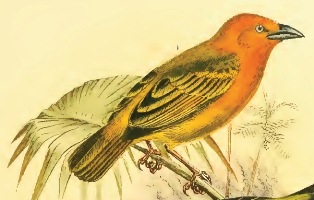Weaver Wednesday [51]: Orange Weaver 2013-06-05 (373)
 Weaver Wednesday
Weaver Wednesday

The Orange Weaver Ploceus aurantius is localized, often uncommon, from coastal West Africa across central Africa to Lake Victoria. The Orange Weaver has a pale slender bill and pale grey eye. The male is orange-yellow, sometimes with a black spot in front of the eye. The female and young birds are dull coloured. There is no seasonal change in plumage.
The Orange Weaver occurs from Sierra Leone in West Africa across to Lake Victoria, and south to northern Angola (see map below, based on Birds of Africa). Two subspecies of the Orange Weaver are recognised:

P. a. aurantius from Sierra Leone to DRC, and south to Angola (see red on map).
P. a. rex, around Lake Victoriain Uganda, Kenya and Tanzania (see blue on map). The male of this subspecies has a larger black area in front of the eye.
A third subspecies, P. a. royrei is not valid but the type may be viewed here.
In Liberia, Orange Weavers are found along the coast and on rocky islets up to 1.5 km offshore, where they nest low down in shrubs on the leeward side but commute to the mainland for foraging.
The Orange Weaver inhabits mangroves, thickets in coastal lagoons, small creeks and esturies in West Africa; inland it occurs along major rivers; and around Lake Victoria it is found in papyrus swamps.
It feeds on fruit, including berries, fruit pulp and seeds; also insects, including adults and eggs of locusts, beetles, and caterpillars. It is usually found in pairs or small groups.

The Orange Weaver is probably polygynous. It is colonial, and there may be between 12 and several hundred nests at some sites, but sometimes single nests. Nest sites include reeds, palms and other trees. It may form mixed colonies with other weavers. The nest is built by the male. The nest is ovoid, with no entrance tunnel in central and West Africa, and with a short tunnel in Uganda. The nest is tightly woven from grass or palm strips.
The Orange Weaver has 1 PHOWN record, from Ghana. Many more PHOWN records are needed for this locally common species (see PHOWN summary). Submit any weaver nest records to PHOWN (PHOtos of Weaver Nests) via the Virtual Museum upload site.
PHOWN summary
Previous Wedn: Little Weaver
Full weaver species list
| 

 Weaver Watch
Weaver Watch


